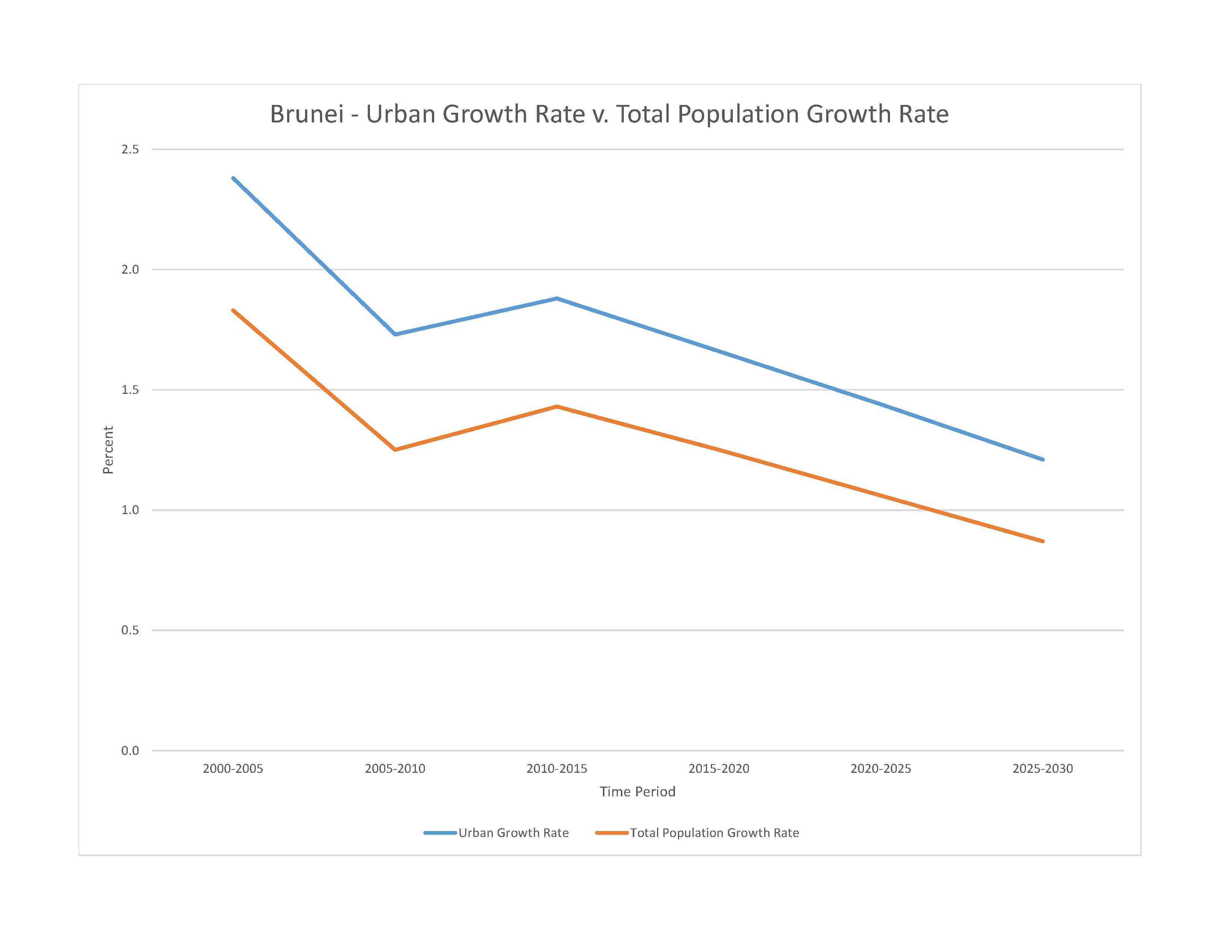
484,991 (2023 est.)
note: immigrants make up approximately 26% of the total population, according to UN data (2019)
noun: Bruneian(s)
adjective: Bruneian
Malay 67.4%, Chinese 9.6%, other 23% (2021 est.)
Malay (Bahasa Melayu) (official), English, Chinese dialects
major-language sample(s):
Buku Fakta Dunia, sumber yang diperlukan untuk maklumat asas. (Malay)
The World Factbook, the indispensable source for basic information.
Malay audio sample:
Muslim (official) 82.1%, Christian 6.7%, Buddhist 6.3%, other 4.9% (2021 est.)
Brunei is a small, oil-rich sultanate of less than half a million people, making it the smallest country in Southeast Asia by population. Its total fertility rate – the average number of births per woman – has been steadily declining over the last few decades, from over 3.5 in the 1980s to below replacement level today at nearly 1.8. The trend is due to women’s increased years of education and participation in the workforce, which have resulted in later marriages and fewer children. Yet, the population continues to grow because of the large number of women of reproductive age and a reliance on foreign labor – mainly from Malaysia, Thailand, the Philippines, Indonesia, and South Asian countries – to fill low-skilled jobs.
Brunei is officially Muslim, and Malay is the official language. The country follows an official Malay national ideology, Malay Islamic Monarchy, which promotes Malay language and culture, Islamic values, and the monarchy. Only seven of Brunei’s native groups are recognized in the constitution and are defined as “Malay” – Brunei Malays, Belait, Kedayan, Dusun, Bisayak, Lun Bawang, and Sama-Baiau. Together they make up about 66% percent of the population and are referred to as the Bumiputera. The Bumiputera are entitled to official privileges, including land ownership, access to certain types of employment (Royal Brunei Armed Forces and Brunei Shell Petroleum), easier access to higher education, and better job opportunities in the civil service.
Brunei’s Chinese population descends from migrants who arrived when Brunei was a British protectorate (1888 and 1984). They are prominent in the non-state commercial sector and account for approximately 10% of the population. Most Bruneian Chinese are permanent residents rather than citizens despite roots going back several generations. Many are stateless and are denied rights granted to citizens, such as land ownership, subsidized health care, and free secondary and university education. Because of the discriminatory policies, the number of Chinese in Brunei has shrunk considerably in the last 50 years. Native ethnic groups that are not included in the Bumiputera are not recognized in the constitution and are not officially identified as “Malay” or automatically granted citizenship. Foreign workers constitute some quarter of the labor force.
0-14 years: 21.83% (male 54,523/female 51,334)
15-64 years: 71.07% (male 164,957/female 179,721)
65 years and over: 7.1% (2023 est.) (male 16,748/female 17,708)
total dependency ratio: 39.2
youth dependency ratio: 31.1
elderly dependency ratio: 8.1
potential support ratio: 12.4 (2021 est.)
total: 32 years (2023 est.)
male: 31.1 years
female: 32.8 years
1.43% (2023 est.)
16 births/1,000 population (2023 est.)
3.9 deaths/1,000 population (2023 est.)
2.2 migrant(s)/1,000 population (2023 est.)
the vast majority of the population is found along the coast in the western part of Brunei, which is separated from the eastern portion by Malaysia; the largest population concentration is in the far north on the western side of the Brunei Bay, in and around the capital of Bandar Seri Begawan
urban population: 79.1% of total population (2023)
rate of urbanization: 1.44% annual rate of change (2020-25 est.)

266,682 BANDAR SERI BEGAWAN (capital) (2021)
note: the boundaries of the capital city were expanded in 2007, greatly increasing the city area; the population of the capital increased tenfold
at birth: 1.05 male(s)/female
0-14 years: 1.06 male(s)/female
15-64 years: 0.92 male(s)/female
65 years and over: 0.95 male(s)/female
total population: 0.95 male(s)/female (2023 est.)
44 deaths/100,000 live births (2020 est.)
total: 10.3 deaths/1,000 live births (2023 est.)
male: 12.6 deaths/1,000 live births
female: 7.9 deaths/1,000 live births
total population: 78.6 years (2023 est.)
male: 76.3 years
female: 81.1 years
1.74 children born/woman (2023 est.)
0.85 (2023 est.)
N/A
improved: urban: 99.7% of population
rural: N/A
total: 99.9% of population
unimproved: urban: 0.4% of population
rural: 0% of population
total: 0.1% of population (2020)
2.4% of GDP (2020)
1.61 physicians/1,000 population (2017)
2.9 beds/1,000 population (2017)
improved: urban: N/A
rural: N/A
total: N/A
unimproved: urban: N/A
rural: N/A
total: N/A
14.1% (2016)
total: 0.69 liters of pure alcohol (2019 est.)
beer: 0.66 liters of pure alcohol (2019 est.)
wine: 0.04 liters of pure alcohol (2019 est.)
spirits: 0 liters of pure alcohol (2019 est.)
other alcohols: 0 liters of pure alcohol (2019 est.)
total: 16.2% (2020 est.)
male: 30% (2020 est.)
female: 2.3% (2020 est.)
N/A
54.3% (2023 est.)
4.4% of GDP (2016 est.)
definition: age 15 and over can read and write
total population: 97.6%
male: 98.3%
female: 96.9% (2021)
total: 14 years
male: 14 years
female: 14 years (2020)
NOTE: The information regarding Brunei on this page is re-published from the 2024 World Fact Book of the United States Central Intelligence Agency and other sources. No claims are made regarding the accuracy of Brunei 2024 information contained here. All suggestions for corrections of any errors about Brunei 2024 should be addressed to the CIA or the source cited on each page.
This page was last modified 04 May 24, Copyright © 2024 ITA all rights reserved.